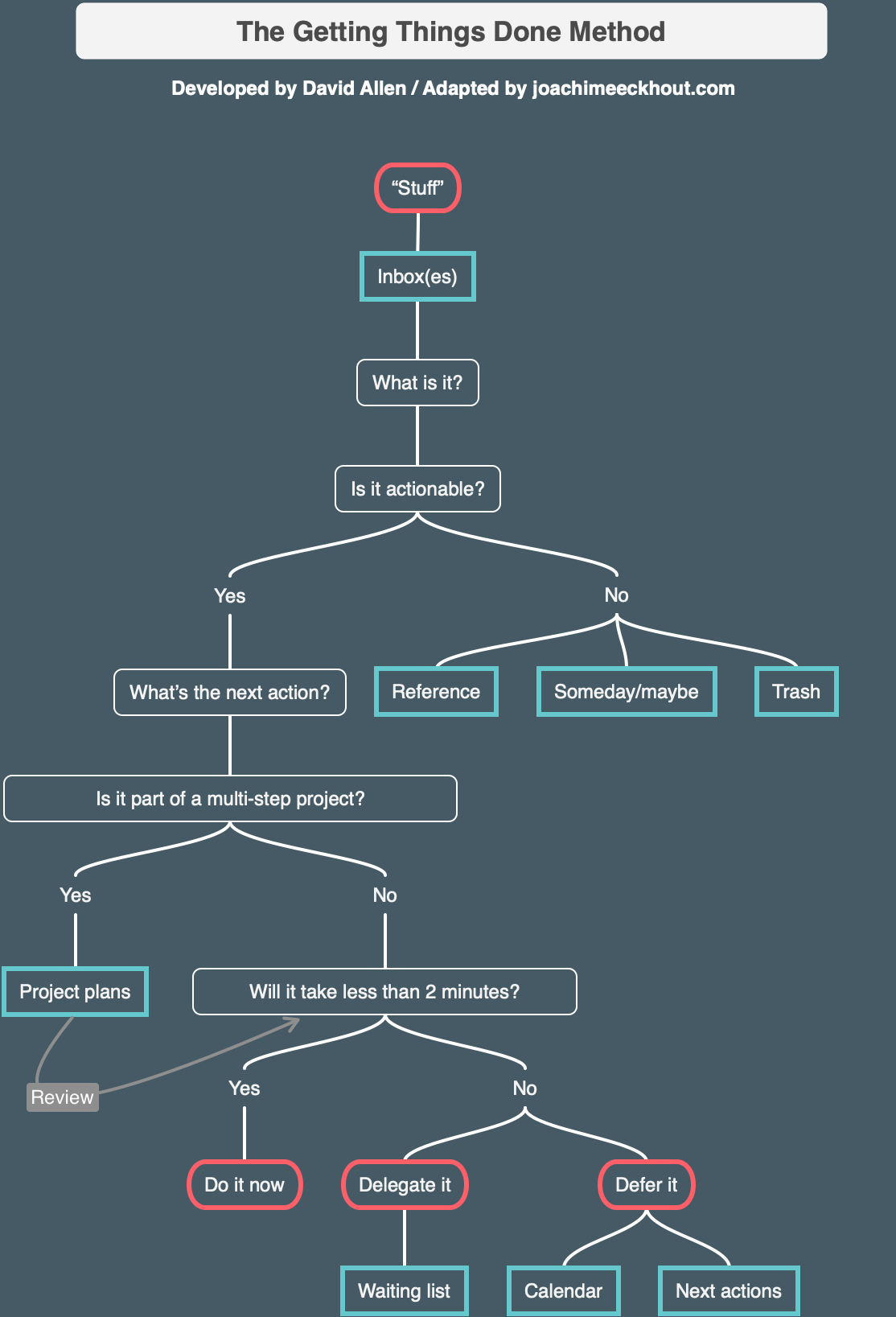When I ask someone about their biggest challenge in marketing, the answer is often the same: they don’t have enough time to do everything that needs to be done.
Time management is THE challenge for knowledge workers, not just marketers. Time is often the only limit to what we can achieve, and when it’s already split between meetings, emails and Slack messages, finding time to do the actual work seems impossible.
My approach to time management has been the same for the last ten years: maximizing the time I spend in the flow, that state of deep concentration that we often experience once we are fully immersed in a task. You know, it's that state where we lose track of time and feel as though our work is unstoppable.
If you haven’t experienced this, then this article is probably for you. So let’s first look at why time management matters.
Why do you need time management?
Working in digital marketing often feels overwhelming. Between social media management, content marketing, growth hacking and the latest marketing buzzword, it's easy to feel lost in the plethora of activities we have to manage.
Which brings us to the number one time waster: changing focus too often.
I don’t believe in multitasking. Our brains aren’t designed to focus on two things simultaneously. Multitasking has been studied over and over again and the conclusion is always the same: task switching has a high cost to our productivity (according to some studies, it can reduce our productivity by up to 40%).
That’s why time management has to start with the key principle of avoiding task switching at all costs. This allows for long, uninterrupted periods of focus, or deep work, as author Cal Newport likes to call it.
Once you get rid of the distractions, you can start working on that big project you have been putting off for so long. So let's look at how to do this.
Start by removing distractions
The breakthrough for my time management came when I realised that a day could be broken down into specialised parts.
Most people who struggle with their time have something in common: they react to external signals, which results in their day being a succession of tasks they didn't plan ahead.
Email is the worst enemy of productivity. If your emails sit in front of you all day, or worse, if you get a notification every time you get an email, chances are you won't get much done in your day.
Once I understood this, I took strict measures to protect my time:
- I removed all notifications from my phone and computer. This includes the red dot on apps, which is a visual clutter that only triggers you to open the app.
- I decided to allow meetings only in the afternoons and only 3 days a week, which leaves plenty of time to work on bigger tasks instead of being interrupted by meetings all day.
- I introduced asynchronous communication to my team, which allowed me to choose what time of day I wanted to communicate, while not being a bottleneck for the rest of the team.
Going through all of this would take several articles, and if you want to go deeper, my old blog is full of time management tips. But if there's one thing you should take away from this, it's that time management is an active practice that requires compromise.
You can't be a boss-pleaser if you've chosen to be a high achiever. Productivity requires focus, focus requires time, and protecting your time requires building barriers around you. Some people will get it, some won't, but what's important is that you communicate clearly about how you work.
But whatever you do, there will always be distractions around you. So let's look at how you can actually channel all those distractions into a better system.
Getting Things Done
I got into time management not by choice, but by necessity. Building a business is hard and overwhelming. There are always more things to do than you can handle, and I realised early on that simply putting everything on a to-do list wasn't going to be enough to manage the stress of this never-ending struggle.
That’s when I came across a book I’ve read many times since: Getting Things Done by David Allen.
I won't go into too much detail here, because you can read a lot about this technique online (I wrote a post about it on my old blog).
The main teaching of this method is to treat all the input you receive during the day (emails, messages, discussions in meetings, etc.) within a single and consistent workflow.
The workflow looks daunting at first, but once you get the hang of it, it becomes a second nature:

This way of collecting, sorting and acting on input becomes second nature after a while, and once you have this system in place, it makes it very easy to decide what to work on next without stressing about deadlines.
For example, whenever you come across an email, you'll use a logic tree to decide what to do with it. If the resulting action takes less than two minutes to complete, you should do it now, otherwise it should be deferred for later.
GTD has completely changed the way I work with my to-do list. But what I've found is that this workflow alone isn't enough, because if you have input coming at you all the time, you're still going to get distracted.
That's where time blocking comes in.
Use time blocking to batch your tasks
We often think of our calendar as a place to keep track of our meetings, but what if you could use it to book appointments with yourself?
Time blocking consists of blocking time in your agenda for specific tasks, rather than simply keeping them on your to-do list. I like to think of it as a 3D view of my time. When things are on my to-do list, they look flat, without giving me a sense of the space they will take up in my day. Once I allocate time to them, I can see their volume and try to fit them into my schedule. If they take several hours to complete, I can see if they fit or not into my schedule.
That’s where task batching comes into play. As I said earlier, there is a productivity cost to constantly switching between tasks (called the switch-cost effect ). Our brains react more slowly when we switch to a new task. So to avoid this, it's better to group similar tasks one after the other.
For example, I set aside one or two time slots a day to go through my emails, Slack messages and other written communications. In this way, I put myself in "communication mode". Outside of this dedicated time, I don't even open these apps.
The result is a radical change in the time available during the day:

Task batching can be used for many things. I also use it to edit articles (a big part of my time) or even to batch my meetings into concentrated periods of time.
These techniques open up long slots of time where you can book time for your bigger tasks, like setting up a complex email automation or working on your content marketing plan for the year.
An extension of this technique if you are a freelancer is to divide your time by client during the week. For example, you could allocate all your Mondays to client A, while Tuesdays are dedicated to client B. If you need more regular touchpoints, you could instead block half days throughout the week for a particular client.
This is great for two reasons:
- You can focus on the project related to only one client, and it's also easier to track the time you've spent on that particular client.
- You can let your client know that a certain amount of time is dedicated to them, which makes communication easier and builds trust.
For this technique to work, make sure you have a way of blocking incoming messages that are not related to that client, otherwise you'll get distracted by other priorities and batching won't work.
Understand what’s urgent and what’s important
With most of the new recruits I hired over the years, I have observed the same problem with their perception of priorities.
In the context of work, it's often very difficult to recognise what's important, what's urgent, or what can simply be avoided
I've seen people waste countless hours on menial tasks that don't move the needle at all. But to the person doing the task, it seemed to be the most important thing on their plate.
I often mention the Eisenhower Matrix to help people understand this. If you've never heard of it, it's named after US President Dwight D. Eisenhower, who famously used it to decide what to prioritise, and it looks like this:

The first thing to understand about prioritising your tasks is the difference between what's urgent and what's important. Important tasks are not necessarily urgent. The Mere Urgency Effect always pushes us to prioritize tasks that feel time-sensitive, rather than thinking rationally. That's why we always prefer to answer our emails instead of working on a task that could have a big impact on our business.
Here's how I recognize a truly urgent task: if you don't do it now, something bad will happen RIGHT NOW.
Everything else isn't urgent and can either be scheduled for later if it's important, delegated to someone else, or simply avoided.
Thinking like this changes a lot of things, especially when it comes to delegation.
Delegating is hard, especially if you're an entrepreneur or freelancer, because we always think we can do it better than anyone else. But trying to do everything never works, and there's always a point where we need to start delegating.
The Eisenhower Matrix helped me realize that a lot of tasks were just keeping me from focusing on the best work I could do.
Automate the repetitive tasks
Whenever I find myself repeating a simple task, I always try to think of a way to either avoid it or automate it. Call me lazy, but this has been a huge time saver over the years.
The great thing about automation is that it's never been easier to implement, and you don't have to be a developer to do it.
Services like Zapier or n8n let you connect the applications you already use and create workflows between them. For example, I use it to automatically migrate users from two services I use to send my newsletter. You can also automate anything like repetitive reporting tasks, emails, billing, etc.
Automation is also often implemented within apps. I use Notion as my project management and note-taking app, and you can easily set up automation directly in it. For example, in a project management board, you could automatically move projects when they reach a certain status, or trigger a certain action when you check a box or add a tag.
It might feel like it's nothing, but when you add up all these little automations, you end up with a lot of time saved.
I've also realized that it's always better to keep things as simple as possible. I only set up an automation when I see a task that really needs to be done, but would involve a lot of manual work.
I've had to build very complex automations in the past, sometimes it works, sometimes it doesn't, but I've often realized after the fact that some part of the automation could have just been avoided altogether because it wasn't really important.
Wrap everything up in a weekly review
Finally, the last key element of my time management toolkit is my weekly review. Every Friday, I set aside an hour to review my week. I look at how I spent my time, which tasks were really important and which were time wasters. I try to think about how I could have done better, and most importantly, I plan for the next week.
Taking this time to reflect has a huge positive impact. It helps me to better estimate how much time future tasks will take (humans are famously really bad at this) or to reprioritize my tasks.
Some people prefer to do their review over the weekend or on Mondays. It's really up to you, but my advice is to keep it consistent and set aside at least an hour to really take the time to reflect.
We often feel overwhelmed and burned out because we don't take the time to stop and take a good look at what's driving us so crazy. Most of the time it's easy to figure out, but we need time to realize it.
Let go of the guilt
I won't lie, managing your time effectively is going to make you feel guilty. Spending three hours in deep work is hard at first, not because we lack focus, but because we constantly want to open our emails to make sure we're not missing anything. FOMO effect, right?
I've been working asynchronously for at least five years, and I can tell you that there are times when I can't resist the temptation of my inbox. It's just a quick check, after all, what is it going to cost? Two hours later, I'm still responding to the dozens of emails waiting in my inbox.
Deep work is like a strict diet, you either go all out to remove the sugar from your life, or you go back and forth between episodes of weight gain.
Look, it's not our fault. We're dopamine addicts, and all this beautiful technology that surrounds us is literally programmed to give us a jolt every time we use it. I feel so satisfied every time I clear my inbox. And don't get me started on social media, which is a productivity nightmare.
So remember, you're not going to become Bouddha in a day, managing your focus is a lifelong struggle for any knowledge worker, but you can at least start somewhere, and if you take just 1% of this article, I feel like that's already a great achievement for me.
So go ahead, remove those notifications from your phone. You'll thank me later.





